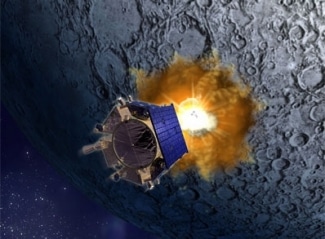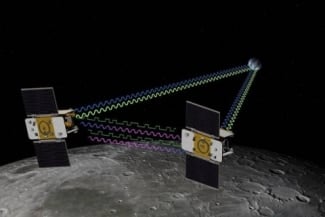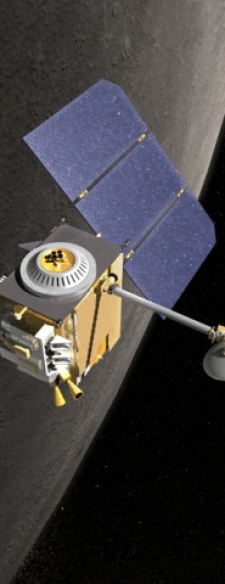Current Moon Exploration
Current Moon Exploration
Although astronauts last walked on the Moon in 1972, the exploration of the Moon with robotic spacecraft has sporadically continued through the years since, with some exciting developments in recent years-including verification of water on the Moon.
Event Access:

Lunar Reconnaissance Orbiter (LRO)

Payload
The LRO payload, comprising six instruments and one technology demonstration, is providing key datasets to enable a human return to the Moon. The instruments include:
Cosmic Ray Telescope for the Effects of Radiation (CRaTER) characterizes lunar radiation, determines potential biological impact and tests radiation effects and shielding models to enable development of protective technologies.
- Diviner Lunar Radiometer Experiment (DLRE) provides orbital thermal mapping measurements, giving detailed information about surface and subsurface temperatures and landing hazards.
- Lyman-Alpha Mapping Project (LAMP) maps the lunar surface in far ultraviolet, searches for polar surface ice and frost and provides images of permanently shadowed regions illuminated only by starlight.
- Lunar Exploration Neutron Detector (LEND) creates high-resolution hydrogen distribution maps, provides information about lunar radiation, searches for evidence of water ice on the Moon’s surface and provides space radiation environment measurements useful for future human exploration.
- Lunar Orbiter Laser Altimeter (LOLA) measures landing site slopes and lunar surface roughness, generates a high-resolution 3D map of the Moon and identifies permanently illuminated and permanently shadowed areas by analyzing Lunar surface elevations.
- Lunar Reconnaissance Orbiter Camera (LROC) retrieves high-resolution black and white images of the lunar surface, capturing images with resolutions down to 1m and imaging the lunar surface in color and ultraviolet to enable safe landing site selection.
- Mini-RF Technology Demonstration searches for subsurface water ice deposits and takes high-resolution images of permanently-shadowed regions.
Even with some initial failures, LRO has already collected as much data as all other planetary missions combined. It has identified, among other things, hardware still remaining at the six Apollo landing sites.

- The first images from LRO were published on July 2, 2009, showing a region in the lunar highlands south of Mare Nubium (Sea of Clouds)
- On Aug. 21, 2009, the spacecraft, along with the Chandrayaan-1 orbiter, attempted to perform a bistatic radar experiment to detect the presence of water ice on the lunar surface; the attempt was a failure because Chandrayaan-1 radar was not pointed at the Moon during the experiment.
- On Dec. 17, 2010, the most accurate topographic map of the Moon to date based on data gathered by the LOLA instrument was released to the public.
- On March 15, 2011, the final set of data from the exploration phase of the mission was released to the NASA Planetary Data System; among the latest products is a global map with a resolution of 100 meters per pixel from the LROC.
Lunar Crater Observation and Sensing Satellite (LCROSS)

The mission employed the unusual technique of crashing a spacecraft into the Moon in order to observe and analyze the resulting debris plume created by the impact.
Holding on to a Centaur upper stage booster rocket, the LCROSS shepherding spacecraft orbited the Earth and Moon for several months to achieve the mission’s optimal impact angle, which was important to accomplish the largest debris plume possible. Plus, the long orbit depleted the spacecraft’s fuel supply to prevent lunar contamination. On Oct. 9, 2009, the Centaur rocket separated from the LCROSS shepherding spacecraft and crashed into the Cabeus crater near the south pole of the Moon. Following four minutes behind the Centaur, the LCROSS shepherding spacecraft passed through the resulting debris plume, collecting and relaying data until it also crashed into the crater.
Using spectrometers, cameras and a radiometer, LCROSS captured data of the debris plume as it encountered sunlight, which causes water-ice, hydrocarbons or organics to vaporize and break down into their basic components. In November 2009, NASA scientists confirmed that the plume did, indeed, contain water ice – in larger amounts than originally suspected. This is an important finding that could influence future lunar exploration.
The Space Foundation recognized the LCROSS mission in 2010 with our John L. “Jack” Swigert, Jr., Award for Space Exploration (pictured, right).
For more information about LCROSS, click here.
Gravity Recovery and Interior Laboratory (GRAIL)

The two GRAIL spacecraft are near-twins, each about the size of a washing machine, with minor differences resulting from the need for Flow to follow Ebb as they circle the Moon.
Each spacecraft carries a set of cameras for MoonKAM (Moon Knowledge Acquired by Middle school students), marking the first time a NASA planetary mission has carried instruments expressly for education and public outreach.

In a NASA competition, Ebb and Flow were named by fourth grade students at Emily Dickinson Elementary School in Bozeman, Mont. (pictured, right).
For more information, click here.

 Cosmic Ray Telescope for the Effects of Radiation (CRaTER) characterizes lunar radiation, determines potential biological impact and tests radiation effects and shielding models to enable development of protective technologies.
Cosmic Ray Telescope for the Effects of Radiation (CRaTER) characterizes lunar radiation, determines potential biological impact and tests radiation effects and shielding models to enable development of protective technologies.